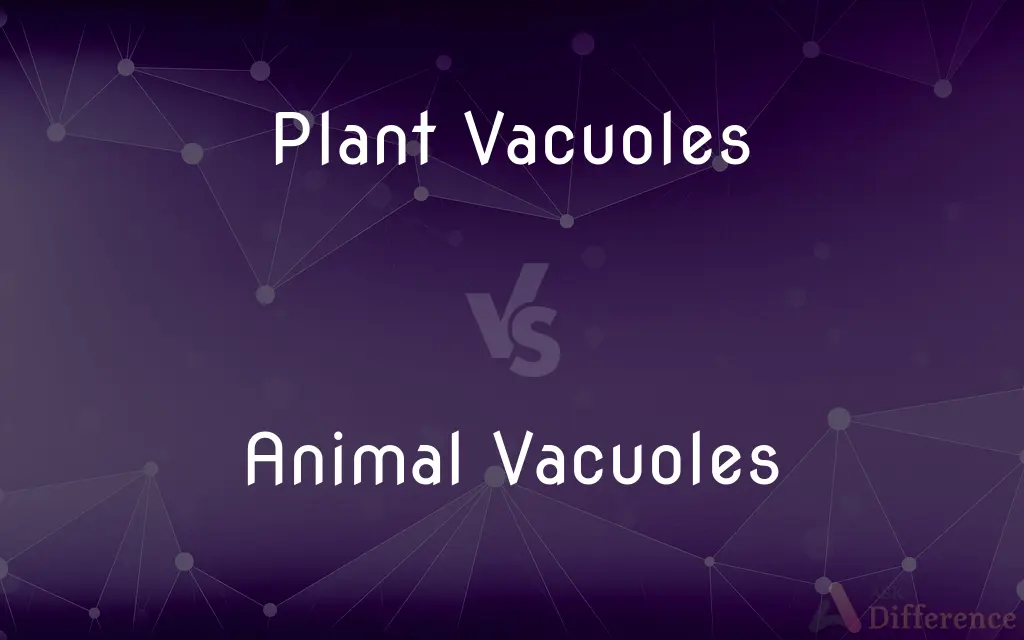Plant Vacuoles vs. Animal Vacuoles — What's the Difference?
Edited by Tayyaba Rehman — By Fiza Rafique — Published on December 11, 2023
Plant Vacuoles are large central organelles storing water, nutrients, and waste, while Animal Vacuoles are smaller, temporary structures primarily involved in transporting substances.

Difference Between Plant Vacuoles and Animal Vacuoles
Table of Contents
ADVERTISEMENT
Key Differences
Plant Vacuoles are prominent organelles occupying a significant portion of a plant cell's volume, often giving the cell its turgid appearance. Animal Vacuoles, in contrast, are much smaller in size and more transient in nature, adjusting based on the cell's needs.
A primary role of Plant Vacuoles is to maintain turgor pressure, which provides structural support to the plant. This is achieved by storing water and ions. Animal Vacuoles, on the other hand, don't contribute to cell rigidity but rather help in the transport and breakdown of materials.
The tonoplast is the membrane surrounding Plant Vacuoles, ensuring the selective transportation of substances in and out. Animal Vacuoles often form from the fusion of vesicles, evolving for specific purposes, like food vacuoles formed after phagocytosis.
Plant Vacuoles also play a role in waste management, storing waste products and potentially harmful substances. Conversely, Animal Vacuoles function in a series of events: they encapsulate materials, transport them, and sometimes fuse with lysosomes for digestion.
It's essential to understand that while both Plant and Animal Vacuoles share the name "vacuole," they differ in function, size, and importance to the cell's physiology and overall structure.
ADVERTISEMENT
Comparison Chart
Size and Number
Large and central, typically one per cell
Smaller and multiple, varying in number per cell
Main Function
Storage (water, ions, waste)
Transport, digestion, and waste removal
Membrane
Tonoplast
Derived from vesicles
Importance
Provides turgidity to plant cells
Temporary and specific to cell needs
Formation
Consistent presence from cell's early stages
Form and dissipate based on cellular activities
Compare with Definitions
Plant Vacuoles
A reservoir for waste and potentially harmful substances in plant cells.
Toxins in some plants are stored in their Plant Vacuoles.
Animal Vacuoles
A component for waste encapsulation and removal in animal cells.
Excess substances are often enclosed in Animal Vacuoles for excretion.
Plant Vacuoles
An essential component in plant cells for maintaining cell structure.
When the Plant Vacuole loses water, the plant wilts.
Animal Vacuoles
An organelle assisting in intracellular digestion.
Lysosomes fuse with Animal Vacuoles to break down captured bacteria.
Plant Vacuoles
A large central organelle in plant cells storing water and nutrients.
The turgidity of the plant cell is maintained by its Plant Vacuole.
Animal Vacuoles
A vesicle-derived structure involved in various cellular activities.
Animal Vacuoles change in number and size based on cell needs.
Plant Vacuoles
An organelle contributing to plant cell's osmoregulation.
Osmotic balance in plant cells is maintained by the Plant Vacuole.
Animal Vacuoles
A small, temporary cellular structure for transporting substances.
After engulfing food particles, the cell forms an Animal Vacuole for digestion.
Plant Vacuoles
A cell component encapsulated by the tonoplast membrane.
The Plant Vacuole ensures selective transport through its tonoplast.
Animal Vacuoles
A dynamic structure formed for specific cellular processes.
Phagocytic cells form Animal Vacuoles to encapsulate foreign particles.
Common Curiosities
Do Animal Vacuoles play a role in digestion?
Yes, some Animal Vacuoles, especially food vacuoles, fuse with lysosomes to aid digestion.
Are there multiple Plant Vacuoles in a single plant cell?
Typically, plant cells have a single, large central Plant Vacuole.
What membrane surrounds the Plant Vacuole?
The Plant Vacuole is surrounded by the tonoplast membrane.
Can Animal Vacuoles be of varying sizes?
Yes, Animal Vacuoles vary in size and number based on their function and the cell's needs.
Are Animal Vacuoles permanent structures?
No, Animal Vacuoles are temporary, forming and dissipating based on cellular needs.
How do Animal Vacuoles form?
Animal Vacuoles often form from the fusion of vesicles, especially after processes like phagocytosis.
Can Plant Vacuoles change in size?
Yes, Plant Vacuoles can adjust in size, especially in response to water availability.
How do Animal Vacuoles assist in waste removal?
Animal Vacuoles encapsulate waste materials, which are then transported to the cell surface for excretion.
How do Plant Vacuoles contribute to a plant's rigidity?
Plant Vacuoles store water, providing turgor pressure, which gives the plant its rigidity.
What happens when a Plant Vacuole loses water?
When a Plant Vacuole loses water, the plant cell loses turgidity, causing the plant to wilt.
Do Plant Vacuoles store harmful substances?
Yes, Plant Vacuoles can store toxins and waste products.
Are Animal Vacuoles found in every animal cell?
Not necessarily. Animal Vacuoles form based on specific cellular activities and needs.
Do Plant Vacuoles aid in osmoregulation?
Yes, Plant Vacuoles play a crucial role in osmoregulation by maintaining osmotic balance.
What is the primary role of Plant Vacuoles?
The primary role of Plant Vacuoles is storage – of water, ions, nutrients, and waste.
What substances can Animal Vacuoles transport?
Animal Vacuoles can transport enzymes, nutrients, waste products, and other cellular materials.
Share Your Discovery

Previous Comparison
FDI vs. FII
Next Comparison
Capitalise vs. CapitalizeAuthor Spotlight
Written by
Fiza RafiqueFiza Rafique is a skilled content writer at AskDifference.com, where she meticulously refines and enhances written pieces. Drawing from her vast editorial expertise, Fiza ensures clarity, accuracy, and precision in every article. Passionate about language, she continually seeks to elevate the quality of content for readers worldwide.
Edited by
Tayyaba RehmanTayyaba Rehman is a distinguished writer, currently serving as a primary contributor to askdifference.com. As a researcher in semantics and etymology, Tayyaba's passion for the complexity of languages and their distinctions has found a perfect home on the platform. Tayyaba delves into the intricacies of language, distinguishing between commonly confused words and phrases, thereby providing clarity for readers worldwide.
















































